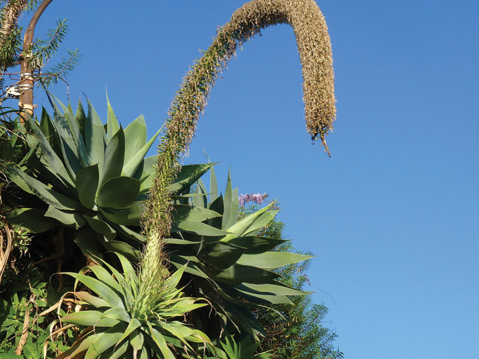Foxtail Agave
Weirdly Wonderful Flower Spikes

It’s an annual phenomenon. Some years are better than others, and sometimes the show is early, sometimes late. This year, it looks to be a modest but still striking floral display, and it seems to be decidedly later than the normal average. All over town, the foxtail agaves (Agave attenuata) are sending up their weirdly wonderful flower spikes. They emerge from the center of the plant, clothed in narrow succulent bracts that twist around the central stem. The inflorescence grows sometimes at a truly astounding rate of several inches a day and can ultimately reach up to 10 feet in length. Each stalk arches up and over, usually facing the direction of greatest sunlight. So a row of foxtail agaves seems to form a sculptural, vegetable arcade.
Late summer and early fall are the usual seasons for their reproductive push. The plants that have been around for 10 years or so react to the sexual cue to be fruitful and multiply. Only once in their lifetime these succulents really go all out, pumping all their energy into that one flower stalk, covered with hundreds of cream-colored tubular flowers. This effort does have its consequences. Most agaves are what botanists call monocarpic. In short, these plants expend their all in the production of seed and then die. The upside, of course, is lots of seed to carry on the race. Foxtail agave also employs another strategy by producing small plantlets or bulbils along the flower stalk that drop off and (hopefully) root nearby. Another means of vegetative reproduction is to produce offshoots — or “pups” — from their base or lower stems to carry on the genetic stock.
As showy as the flower stalks are during the day, there are reasons to enjoy this friendly succulent after hours, too. Plants that are bluish or gray in the light of day (usually a strategy to keep cool then) show another face at night. Of course, if they reflect the noonday sun, they should reflect the moon glow, too. The ubiquitous rosettes of Agave attenuata take on a silvery sheen, especially if they are moistened by a little dew. A nighttime drive along Alameda Padre Serra will reveal many foxtail agaves that glow in the light from streetlights and car headlights.
This broad-leafed agave is planted in abundance throughout Southern California, and Santa Barbara is no exception. Most specimens are a pale grayish green, although you may also encounter some decidedly silvery-blue ones. As common as A. attenuata is around here, it has always been relatively rare in its native habitat. In the Mexican states of Mexico and Jalisco, it occurs on dry, rocky hillsides in rather sparse colonies. These populations are generally found in pine forests, which explains why A. attenuata is one of the few agaves that does well in some shade. In fact, in California’s interior valleys, it can sunburn easily without some cover. Of course, on the coast it thrives in exposed situations equally as well as more shady spots. Once established, foxtail agaves need no additional water, but may be damaged by temperatures below 25º F.
Enjoy the floral show for the next few months, but have a look at them by night, as well.



